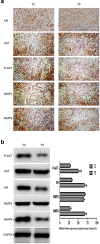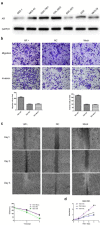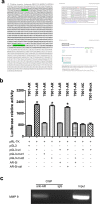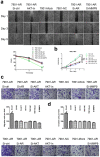Androgen receptor promotes gastric cancer cell migration and invasion via AKT-phosphorylation dependent upregulation of matrix metalloproteinase 9
- PMID: 25301736
- PMCID: PMC4279395
- DOI: 10.18632/oncotarget.2513
Androgen receptor promotes gastric cancer cell migration and invasion via AKT-phosphorylation dependent upregulation of matrix metalloproteinase 9
Retraction in
-
Retraction: Androgen receptor promotes gastric cancer cell migration and invasion via AKT-phosphorylation dependent upregulation of matrix metalloproteinase 9.Oncotarget. 2025 May 29;16:410. doi: 10.18632/oncotarget.28736. Oncotarget. 2025. PMID: 40439455 Free PMC article. No abstract available.
Abstract
Androgen receptor (AR) plays an important role in many kinds of cancers. However, the molecular mechanisms of AR in gastric cancer (GC) are poorly characterized. Here, we investigated the role of AR in GC cell migration, invasion and metastatic potential. Our data showed that AR expression was positively correlated with lymph node metastasis and late TNM stages. These findings were accompanied by activation of AKT and upregulation of matrix metalloproteinase 9 (MMP9). AR overexpression induced increases in GC cell migration, invasion and proliferation in vitro and in vivo. These effects were attenuated by inhibition of AKT, AR and MMP9. AR overexpression upregulated MMP9 protein levels, whereas this effect was counteracted by AR siRNA. Inhibition of AKT by siRNA or an inhibitor (MK-2206 2HC) decreased AR protein expression in both stably transfected and parental SGC-7901 cells. Luciferase reporter and chromatin immunoprecipitation assays demonstrated that AR bound to the AR-binding sites of the MMP9 promoter. In summary, AR overexpression induced by AKT phosphorylation upregulated MMP9 by binding to its promoter region to promote gastric carcinogenesis. The AKT/AR/MMP9 pathway plays an important role in GC metastasis and may be a novel therapeutic target for GC treatment.
Conflict of interest statement
There no potential conflicts of interest to declare.
Figures






Similar articles
-
IL-1β-induced activation of p38 promotes metastasis in gastric adenocarcinoma via upregulation of AP-1/c-fos, MMP2 and MMP9.Mol Cancer. 2014 Jan 31;13:18. doi: 10.1186/1476-4598-13-18. Mol Cancer. 2014. PMID: 24479681 Free PMC article.
-
MiR-148a Functions as a Tumor Suppressor by Targeting CCK-BR via Inactivating STAT3 and Akt in Human Gastric Cancer.PLoS One. 2016 Aug 12;11(8):e0158961. doi: 10.1371/journal.pone.0158961. eCollection 2016. PLoS One. 2016. PMID: 27518872 Free PMC article.
-
The functional interlink between AR and MMP9/VEGF signaling axis is mediated through PIP5K1α/pAKT in prostate cancer.Int J Cancer. 2020 Mar 15;146(6):1686-1699. doi: 10.1002/ijc.32607. Epub 2019 Aug 16. Int J Cancer. 2020. PMID: 31381135 Free PMC article.
-
Metastatic function of BMP-2 in gastric cancer cells: the role of PI3K/AKT, MAPK, the NF-κB pathway, and MMP-9 expression.Exp Cell Res. 2011 Jul 15;317(12):1746-62. doi: 10.1016/j.yexcr.2011.04.006. Epub 2011 Apr 30. Exp Cell Res. 2011. PMID: 21570392
-
CEACAM6 promotes gastric cancer invasion and metastasis by inducing epithelial-mesenchymal transition via PI3K/AKT signaling pathway.PLoS One. 2014 Nov 14;9(11):e112908. doi: 10.1371/journal.pone.0112908. eCollection 2014. PLoS One. 2014. PMID: 25398131 Free PMC article.
Cited by
-
Role of RASEF hypermethylation in cigarette smoke-induced pulmonary arterial smooth muscle remodeling.Respir Res. 2019 Mar 7;20(1):52. doi: 10.1186/s12931-019-1014-1. Respir Res. 2019. PMID: 30845941 Free PMC article.
-
The role of 5α-reductase inhibitors in gastro-oesophageal cancer risk: A nested case-control study.Pharmacoepidemiol Drug Saf. 2020 Jan;29(1):48-56. doi: 10.1002/pds.4909. Epub 2019 Nov 12. Pharmacoepidemiol Drug Saf. 2020. PMID: 31713940 Free PMC article.
-
Molecular alterations of cancer cell and tumour microenvironment in metastatic gastric cancer.Oncogene. 2018 Sep;37(36):4903-4920. doi: 10.1038/s41388-018-0341-x. Epub 2018 May 23. Oncogene. 2018. PMID: 29795331 Free PMC article. Review.
-
Investigation of the Correlation between Androgen Receptor and ZEB1 and its Value in Progression of Gastric Cancer.Avicenna J Med Biotechnol. 2020 Jan-Mar;12(1):52-60. Avicenna J Med Biotechnol. 2020. PMID: 32153739 Free PMC article.
-
Androgen receptor promotes esophageal cancer cell migration and proliferation via matrix metalloproteinase 2.Tumour Biol. 2015 Aug;36(8):5859-64. doi: 10.1007/s13277-015-3257-x. Epub 2015 Feb 28. Tumour Biol. 2015. PMID: 25724186
References
-
- Negi SS, Agarwal A, Chaudhary A. Flutamide in unresectable pancreatic adenocarcinoma: a randomized, double-blind, placebo-controlled trial. Invest New Drugs. 2006;24(3):189–194. - PubMed
-
- Chen PJ, Yeh SH, Liu WH, Lin CC, Huang HC, Chen CL, Chen DS, Chen PJ. Androgen pathway stimulates MicroRNA-216a transcription to suppress the tumor suppressor in lung cancer-1 gene in early hepatocarcinogenesis. Hepatology. 2012;56(2):632–643. - PubMed
-
- Catalano V, Labianca R, Beretta GD, Gatta G, de Braud F, Van Cutsem E. Gastric cancer. Crit Rev Oncol Hematol. 2009;71(2):127–164. - PubMed
-
- Feng H, Cheng ASL, Tsang DP, Li MS, Go MY, Cheung YS, Zhao GJ, Ng SS, Lin MC, Yu J, Lai PB, To KF, Sung JJY. Cell cycle-related kinase is a direct androgen receptor-regulated gene that drives beta-catenin/T cell factor-dependent hepatocarcinogenesis. J Clin Invest. 2011;121(8):3159–3175. - PMC - PubMed
Publication types
MeSH terms
Substances
LinkOut - more resources
Full Text Sources
Other Literature Sources
Medical
Research Materials
Miscellaneous

